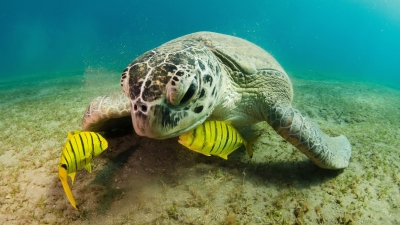
The green sea turtle is the largest hard-shelled sea turtle. They are unique among sea turtles in that they are herbivores, eating mostly seagrasses and algae. This diet is what gives their fat a greenish color (not their shells), which is where their name comes from.
Green turtles are found throughout the world. They nest in over 80 countries and live in the coastal areas of more than 140 countries. Historically, green turtles were exploited for their fat, meat and eggs, causing global population declines. Many countries, including the United States, prohibit the killing of sea turtles and collection of their eggs. However, in some areas, the killing of green turtles for their meat or to supply shells to the wildlife trafficking trade remains a threat to their recovery. Bycatch in commercial and recreational fishing gear, vessel strikes, loss of nesting habitat from coastal development, and climate change are the biggest threats facing green turtles.
NOAA Fisheries and our partners are dedicated to protecting and recovering green turtle populations worldwide. We use a variety of innovative techniques to study, protect, and recover these threatened and endangered populations. We engage our partners as we develop measures and recovery plans that foster the conservation and recovery of green turtles and their habitats. And we fund research, monitoring, and conservation projects to implement priorities outlined in recovery plans.
Credit : NOAA Fisheries
Picture Credit : Google




